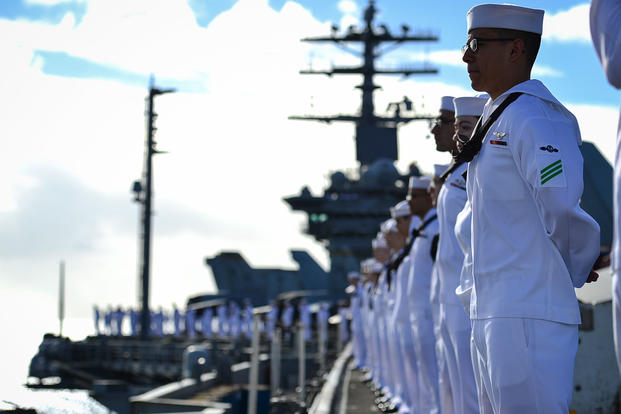Sailors can expect less predictable deployment schedules in the coming year, part of an effort to restore agility to the U.S. naval fleet and confound potential adversaries, Master Chief Petty Officer of the Navy Russell Smith said Thursday.
Unpredictability in Navy deployments is tied to a concept known as dynamic force employment (DFE), associated with the 2018 National Defense Strategy. The idea is to stop telegraphing capability to adversaries and create a more nimble, responsive military force.
For example, the Harry S. Truman Carrier Strike Group completed two erratic, back-to-back three-month deployments last year rather than undertake a standard seven-month deployment cycle to the Middle East.
Speaking at a forum on maritime security at the Center for Strategic and International Studies in Washington, D.C., Smith promised at least three more "dynamic deployments" this year.
"Predictability is a great way to run a shipping line but no way to run a Navy," he said, paraphrasing former Defense Secretary Jim Mattis, a significant contributor to the National Defense Strategy. "We are back to being unpredictable. Dynamic force employment is right out of the '80s where, when we get underway, we are not going to tell you where we are going."
In the past five years, the Navy has struggled with readiness, both within its personnel ranks and its hardware. Nowhere has this been more evident than in the Pacific Fleet, where, in 2017, two fatal collisions involving the U.S.S. Fitzgerald and USS McCain killed 17 sailors. The accidents were blamed on human error due to excessive work schedules, increased mission demand and inadequate training.
Dynamic force employment is designed to enhance readiness and take some of the strain off sailors, some of whom have deployed on ships for up to 10 months.
During its deployment last year, the Truman Strike Group left its home port of Norfolk in April and returned home just three months later. It remained in port for five weeks and left again in August. But instead of heading to the Middle East, the group went to Canada, Iceland, Great Britain and Norway.
"Mission accomplished in the first round," Smith said of the Truman deployment.
In November, the congressionally mandated National Defense Strategy Commission took issue with the concept of dynamic force employment, calling it "imprecise and unpersuasive," and raising concerns that it essentially is an effort to further stretch resources.
"Dynamic force employment appears to refer to creating efficiencies within the force and decreasing the need to expand force structure by having a single asset perform multiple missions in different theaters on a near-simultaneous basis. Yet the United States must confront threats in both the Western Pacific and Europe, two very different theaters that require a significantly different type and mix of forces. ... Given the vast distances involved in reaching both theaters and beyond, DFE may simply place additional strain on already stretched logistics and transportation networks," the commissioners wrote.
Smith said the Navy is implementing dynamic deployments by preserving the traditional maintenance cycle for ships, but "inside the deployment window, we are not going to tell you where we are going."
The unpredictability may be hard on sailors and families, noted forum moderator and U.S. Naval Institute CEO retired Navy Vice Adm. Peter Daly. He added that another issue with unannounced deployments is public perception.
"There's a natural tension there. You want to know people are out there," Daly said.
Smith said the Navy needs to do a better job in outreach, investing "more to make sure our citizens do understand what they are getting for their tax dollars."
Meanwhile, sailors are going to learn how to maintain operational security. "We need to remind sailors that this is kind of cool that we are not going to tell anyone where we are going," he said.
Sergeant Major of the Marine Corps Ronald Green said his service is doing its part to keep the enemy guessing. It has reinstated classes on operational security at boot camp and is rethinking its public message.
"We talk too much. We talk to the world too much about what we are going to do and our capabilities. Now we are talking about what we can talk about in public and what we should be talking about in-house," Green said
Smith said the concepts behind dynamic deployments were among the reasons the U.S. won the Cold War. Today, he added, it's a strategy that remains effective.
"We are going to make the enemy spend money finding us, chasing us, trying to figure out what we are going to do," he said.
-- Patricia Kime can be reached Patricia.Kime@military.com. Follow her on Twitter @patriciakime.












